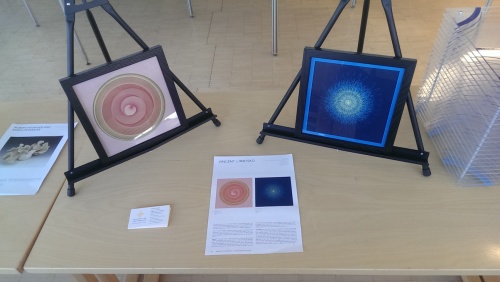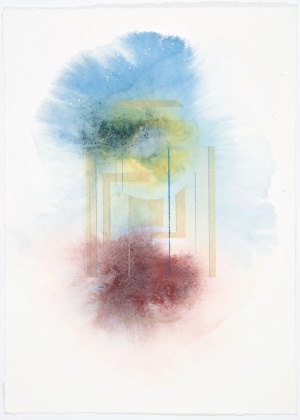Remember from last week we were discussing the following image:

What colors are the squares? Recall that when we allowed one or both squares to be transparent to some degree, there were many possible answers to this question. Last week, we found out all possible color/opacity combinations for the purple square alone.
First, we’ll examine the case that the pink square is transparent and on top of the purple square. Whether the purple square is transparent actually doesn’t matter, so we’ll be perfectly fine if we assume the purple square has RGB values with opacity 1.
To begin, we need to establish the apparent color of the pink square. If I load this image into Photoshop and use the eyedropper tool, I get integer RGB values of Dividing these by 255 to convert to values between 0 and 1, I get
I actually used RGB values of
to create the image, so the eyedropper tool did its job….
Now let’s call the color of the pink square and the opacity
Recall the formula from last week for the result of looking through a transparent color:
In our case, is the color of the pink square, and
is the color of the purple square. So we get the equation
As before, we need to break this down into three separate equations, one for each component. For exactly the same reasons as last week, we must have (go back and reread this argument if you forgot). The equations for the Red and Green components are
which may be rearranged to yield
Since color values lie between 0 and 1, we see from the Red equation that we must have
Note that when this is true, the Green value also lies between 0 and 1, so this is all we need to check. A little simplification shows that this implies so the pink square can be transparent as long as
We can then use the formulas above to fing the Red and Green values (remembering that Blue is always 1). Below are the possibilities in RG space:

The point X corresponds to the value while the point Y corresponds to
Note that while the possible points in RG space lie on a line segment (it is easy to see from the above formulas that
), the points on the line segment do not vary linearly with
since the
occurs in the denominator in the above formulas.
So now we’ve looked at all the possibilities when the pink square is transparent and on top of the purple square. What if the purple square is transparent and on top of the pink square?
We first note that half the work is already done, since we worked out the possibilities for a transparent purple square last week. Here is what we obtained, where again the opacity of the purple square is denoted by :
This corresponds to the color in the formula for opacity. Now let
denote the color of the pink square underneath, which will be
Using the opacity formula, we obtain the equation
This may look a little complicated, but it turns out we only need to look at the Red component. Looking at the Red color value, we get
which after multiplying out and rearranging results in
Can you see any problem with this formula for Since the opacity must be between 0 and 1 — in other words,
— the numerator of this expression will always be greater than the denominator. This means that the Red color value would have to be greater than 1, which we know is not possible!
Our conclusion? It is not possible that the two squares can be obtained by a pinkish square beneath a transparent purple square. Essentially, the pink is “too red.” In order to make the pink show through the purple, the opacity of the purple would have to be too close to 0, which would then mean that we’re not seeing enough blue.
In general, this is not easy to just see by quickly glancing at an image. But if we use the formula for opacity and are careful with our calculations, we can prove that certain color/transparency combinations are impossible.
And what about a more complex figure?

Well, there are four different squares to consider, and several different possible layerings. But it’s even more complicated than that.
What you’re seeing is an image on your color monitor or phone, which is on my website. I got the image from the Wikipedia commons. Someone uploaded a digital file of the image, which was either taken of the original piece, or digitized from a photograph of the piece. Which might have been from a book, published long enough after Albers finished the piece that the photo was actually of a faded original.
So what we’re actually seeing is only an approximation to Albers’ original painting. To make the analysis more realistic, we’d have to assume that the apparent color we’re seeing is within a certain tolerance of the original. Meaning each color doesn’t have just one value, but a range of possible values.
We won’t go into this more complicated issue today. But I hope you now appreciate that an image of just a few squares may be much more intriguing than you might originally think!












 This lovely wheel is often called the Yurmby wheel because it’s somewhat more pronounceable then YRMBCG(Y). The benefit of the Yurmby is that the primary of one system is the secondary of the other. With the RGB system,
This lovely wheel is often called the Yurmby wheel because it’s somewhat more pronounceable then YRMBCG(Y). The benefit of the Yurmby is that the primary of one system is the secondary of the other. With the RGB system,







